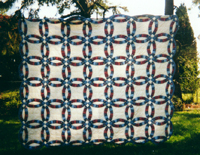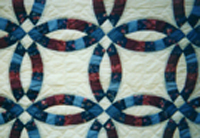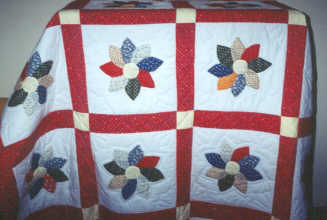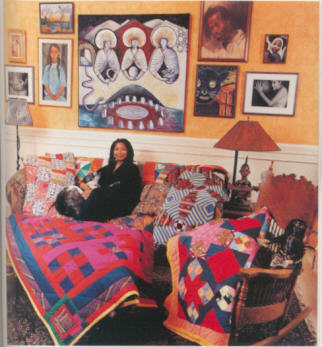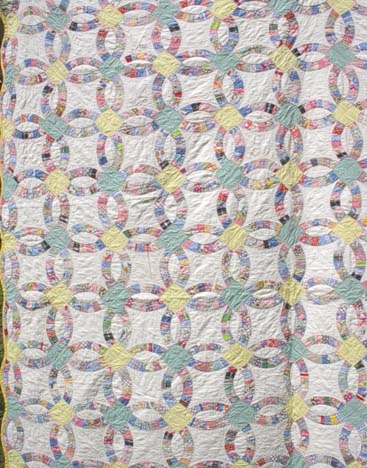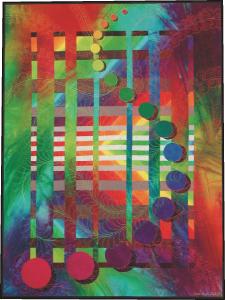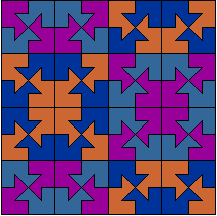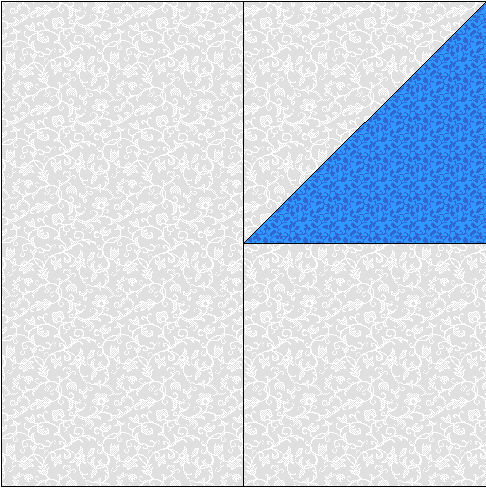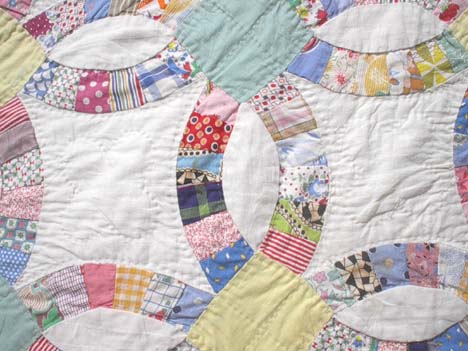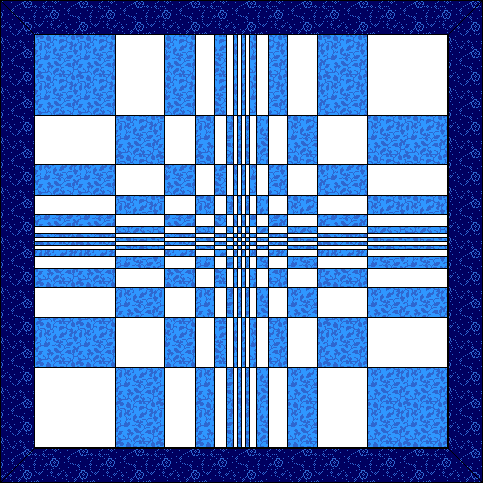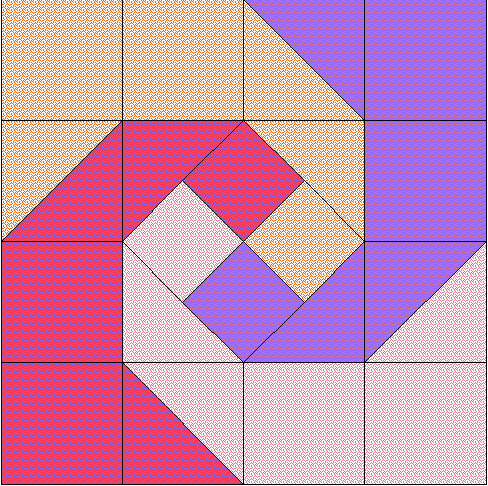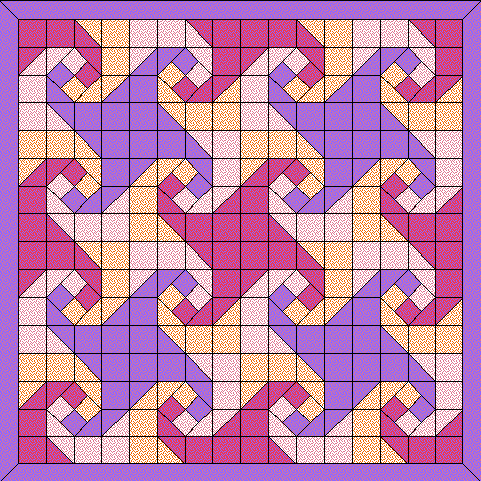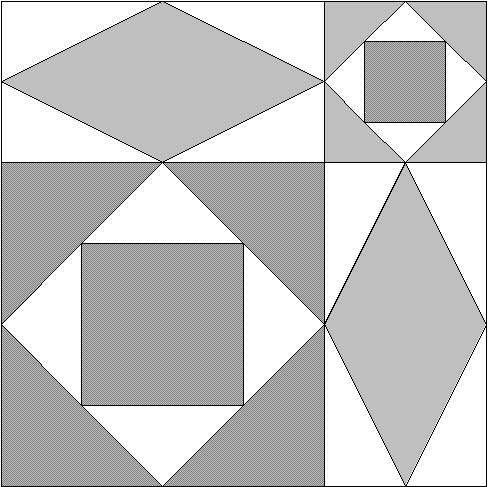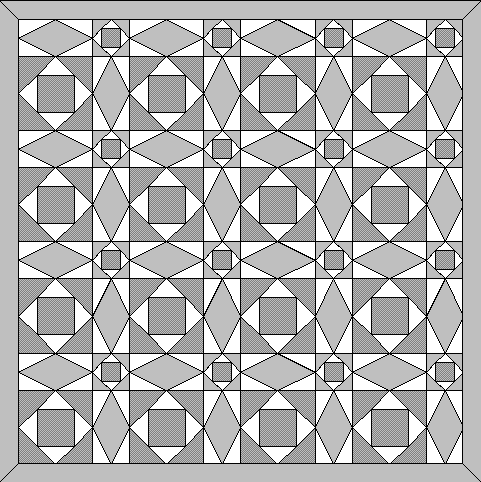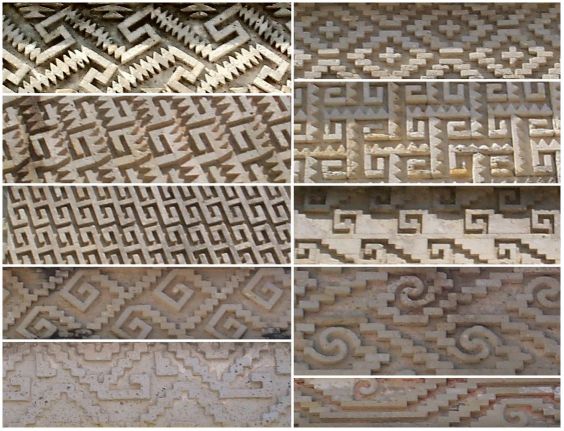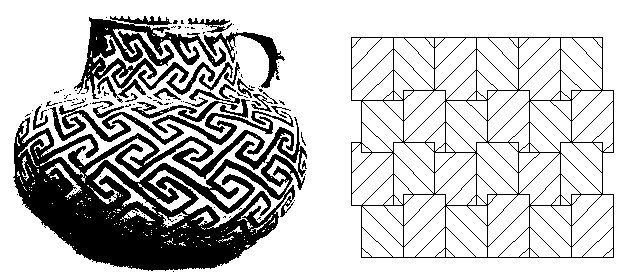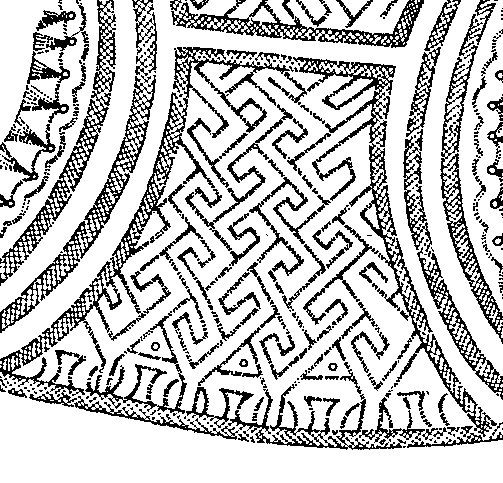|
Daniel F. Daniel
Slavik Jablan
Deb Schmidt
Abstract
For some years I have been beguiled by images of quilts as I emerged from each of the three Bridges Conferences. Perhaps Michael Field is to blame with his exploration of wallpapers and quilt designs through the prism software he has developed. (Prism is an acronym for Programs for the Interactive Study of Maps.) Or Douglas Dunham’s work on Celtic knot patterns. Or all the talk and display of M.C. Escher’s thought and art. I do suspect that Field is right when he notes: "It is well known that some symmetry types seem much more attractive than others. Further, there appears to be a cultural bias in our response to symmetry." [1] I do remain fascinated by the source of that bias in the human aesthetic, if indeed it is a Jungian archetype of some sort and therefore universal. Or even if the aesthetic is localized in some way, the source of that hemispheric or regional aesthetic would command attention. Our purpose here, however, is to draw the reader’s attention to symmetry in the craft and art of the North American quiltmaker. Cultural speculations on aesthetics will be held to a minimum. What I proposed was to choose three quilts and two additional commentators. My own interest has come from watching my mother quilt during the winters in Kentucky. Much later in life she was joined by my father in this communal art form. They had each been making white oak baskets for years. Recently I used an image of one of these "winter quilts" and a poem based on the act of quilting as a response to an event in my professional life. (See appendix) Mine is by far the most innocent of roles as we make this paper. I am a humanist. I am not a mathematician. I am not a quilter. I have invited a mathematician and a quilter to join me in this commentary on quilts. I will add a few other voices of quilters past and present to the mix. In attending our own local quilting gathering recently – a meeting of the Walnut Valley Quilters Guild – I discovered how much I enjoyed listening to the commentary on the quilts as well as seeing the product of the speakers’ efforts. The structure of the paper
is, with the close of this brief introduction, the presentation of three
quilts. I will talk about the Appalachian tradition and use the Double
Wedding Ring to illustrate it. Deb Schmidt will talk
about the use of computer software to design quilts in the late twentieth
and early twenty-first centuries. Slavik Jablan will discuss examples of
quilted, mathematical ideas. While I will create the narrative transitions
and attempt to stitch our three voices together, we each will be sampling
a very small part of an enormously robust and innovative enterprise.
2. Traditional: The Double Wedding Ring My parents work deep within the tradition. Fans and flowers; wedding rings and plane geometry of all sorts dance through their quilts. It is enough to be at home within Appalachian traditions. I do recall my first extended trip through my home state to look at colleges. I was shocked and upset by the pandering to tourists with trivia and geegaws for sale in so many yards throughout the mountains. Bags of sassafras root. Horehound candy. Crudely whittled whistles, birds which, once tipped, would retrieve a toothpick every time or mimic drinking water from a glass, and whirligigs and slingshots in abundance. But always quilts. Quilts hanging by twos and threes on lines in bare side yards. Or thrown over split rail fences, or across the railing around front or side porches. These brilliant quilts were often hung in sharp contrast to the rough hewn log cabins up the holler (hollow) or, more rare, in the bottom land. The display of these mountain riches left me upset for days. Somehow, something sacred and very private was being placed on display for unseeing and uncaring strangers. I don’t think I ever tried to explain that sense of violation to anyone. It was a strange emotion. These were not my quilts and only in the most romantic of world views were they "my people." My parents had long before chosen urban lives and had all but abandoned the farms of their childhoods.
Figure
1: "Double-Wedding Ring" quilt by
Figure
2: Detail of "Double-Wedding Ring"
Figure
3: "Dahlias" by Ruth Daniel. An image of this quilt accompanied
Pulitzer Prize winner Alice Walker comes as close as any contemporary to expressing that sense of the proper place for quilts which is finally in our homes and on our beds. Something becomes lost when we would buy back our heritage (or the heritage of others) and hang it on walls. In a story titled "Everyday Use" Walker offers a family reunion in which Dee, the big city sister, returns home for a visit. (The reader can only imagine Georgia, Walker’s birthplace or Mississippi, the site of a few jobs during the civil rights era.) She has in tow a black muslim male and she comes bearing the new name "Wangero Leewanika Kemanjo." She has abandoned her original name, the name of an oppressor-- although the family continues to point out that she was named for Aunt Dicie. Dee (Wangero) focuses on a trunk filled with family quilts. "They had been pieced by Grandma Dee and then Big Dee and me had hung them on the quilt frames on the front porch and quilted them. One was in the Lone Star pattern. The other was Walk Around the Mountain. In both of them were scraps of dresses Grandma Dee had worn fifty and more years ago. Bits and pieces of Grandpa Jarrell’s paisley shirts. And one teeny faded blue piece, about the size of a penny matchbox, that was from Great Grandpa Ezra’s uniform that he wore in the Civil War."
Figure
4: Novelist and author Alice Walker at home.
It is left to Mama to negotiate the competing claims of two sisters for the quilts. Dee (Wangero) says, "Maggie can’t appreciate these quilts…. She’d probably be backward enough to put them to everyday use. And Mama muses, "I didn’t want to bring up how I had offered Dee (Wangero) a quilt when she went away to college. Then she had told me they were old-fashioned, out of style." Today Dee is saying, "But they’re priceless!. . . Maggie would put them on the bed and in five years they’d be in rags. Less than that!" To which Mama replies, "She can always make some more…. Maggie knows how to quilt." And "Well", I said, stumped. "What would you do with them?" "Hang them," she said. As if that was the only thing you could do with quilts." [2] Dee (Wangero) returns to the city with Muslim and Polaroids of the visit but without the family quilts. In an interview with Walker for his book on African-American quilters, Roland Freeman asks her "what she would like to say to people in general about quilting." Walker replies,
Freeman celebrates the multi-layered communion symbolized and often created by quilts. For this and other reasons it seems appropriate to begin with a traditional pattern called the Double Wedding Ring. For mine, I will simply quote an old adage embroidered on one quilt:
At your quilting maids don’t dally,
Erica Wilson also offers this story from the lore surrounding the "bridal quilt". The Double Wedding Ring is one of many quilts traditionally created by young girls in anticipation of their marriages. "Anyways, what I was doin’ was settin’ there under the quiltin’ arbor one spring afternoon, April fourteenth, just quiltin’ and dreamin’a dream on ever stitch and just plannin’ who might share em with me. "And this deep, fine voice says, ‘Pardon me, ma’am, but I’ve been seein’ you out here every day for weeks and I jest got up my nerve to come over and speak to you and see what you were workin’ on with such care."
Figure
5: "Double-Wedding Ring" quilt from the
Rings or circles symbolize many things in our material lives, but rarely the lack of a quality, quantity, or a null state. In literature we often point out that writers inevitably view life as a circle, a comedy or communion. Or they view life as a straight line, the linear progression leading to tragedy—loss or loss of life. Thus we get Dante’s Divine Comedy – a Christian comedy or circle and Oedipus Rex—the destruction of a family through generations which leads from death to death to death. I suspect the Greeks were right to be so suspicious of the circle and the idea that "no thing" could exist. But without the zero there is no algebra. Brian Rotman in his semiotic study of the zero says, "Semiotically, it is the language, algebra, in which these consequences were developed, and the opposition such language offers between determinate, possibly unknown, but fixed numbers (constants) and the indeterminate non-numerical entities (variables), that is of primary interest."[6] Rotman continues by pointing out the significance of establishing numbers as non-referential except within a system of signs. This of course was the breakthrough in understanding which enabled the work on natural language of the Swiss linguist, Ferdinand de Saussure. In an oddly homologous way the quilt itself rarely has significance except within an extended family. For Rotman as well as Leibniz we had the generating power in naught and one or in presence and absence or in the one and zero of our boolean logic and for psychotherapist Carl Jung, of the material and non-material world. The circle signifies God as well as ego united with non-ego. [7] The Double Wedding Ring is at once a complex and a richly significant pattern within the culture. The most obvious origin is in the exchange of rings in a traditional Christian wedding. From the United Methodist Hymnal, we have: The exchange of rings is optional. Other tangible symbols may be given in addition to, or instead of, rings. The pastor, taking the rings, may say: The wedding ring is the outward
and visible sign
Signifying to all the uniting
of man and woman
The pastor may bless the giving of rings or other symbols of the marriage: Bless, O Lord, the giving
of these rings,
The common custom is for
the husband to give the wife her ring before the wife gives
In token and pledge
To further puncture our linguistic pretensions about rings, we offer this observation about quilting: "How much piecin’ a quilt
is like livin’ a life! Many a time I’ve set and listened to Parson Page
preachin’ about predestination and free will, and I’ve said to myself,
‘If I could jest git up there in the pulpit with one of my quilts, I could
make life a heap plainer than parson’s makin’ it with his big words.’"
[9]
3. Computers and Quilts When technology is brought to a traditional, handcrafted product, it is inevitably viewed with suspicion. The analytical literature of the West is filled with "machine in the garden" commentaries. From Milton’s "Dark Satanic Mills" to the attacks Thoreau and others made on the arrival of the railroad. I remember when my father’s newspaper replaced hot type with offset presses. And I vividly recall when word came that Bob Dylan had exchanged his acoustic guitar for an electric one and the depression many of us experienced. The arrival of the computer in the world of quilting is a recapitulation of the movement from handwork to looms which foreshadowed the arrival of the computer itself. ("Computers" of course were originally men and women seated at desks doing hand calculations or working with adding machines.) Today we can find software for quilters at companies named Compuquilt, Quilt-Pro, and The Electric Quilt Company. Here is everything from Quilt-Pro version 3 for Windows and for Macs. One reader commenting on software from the Electric Quilt called EQ4 reveals the early days of computer design. "Nobody can tease me about virtual quilts any more, because I create virtual quilts and I’m proud of them! Working virtually I produce more designs and create better looking quilts because making changes is so easy." [10] The drawing tools in Quilt-Pro’s Windows Version 3 includes:
3.1. Computer generated design. Quilters make use of many design tools including graph paper, specialized rulers, copiers (to enlarge or reduce a design), compass, overhead projector, and the computer. Quilt design software aids in the design process by allowing the quilter to draw and color a proposed design, then view a completed quilt on the computer screen, print it on paper, or export it as a graphic image. The designer may also import fabrics into the software in order to create a realistic quilt image. CorelDraw is one of many
tools used by textile artist Caryl Bryer Fallert to create patterns for
her nationally recognized quilts. The 2000 American Quilt Society winner
of Best of Show for her quilt, "Birds of a Different Color," Fallert is
very generous about sharing her design secrets. A series of drawings from
CorelDraw are given on her website for one quilt in her Fibonacci
Series #3: Rainbow Garden. [12] She begins with
a design idea and draws it many different ways in CorelDraw, coloring it
until satisfied with the final design. The design is then transferred to
paper in the actual size of the quilt, and the paper pattern is used as
a foundation for piecing the fabrics. (Fibonacci Series #3: Rainbow Garden
http://www.bryerpatch.com/images/quiltrecords/fib3/qrec_fib3.htm)
Figure
6: "Fibonacci Series #3: Rainbow Garden" by
The Electric Quilt Company calls the latest version of its quilt design software EQ4. This PC compatible software has a companion product called BlockBase, which is the electronic version of Barbara Brackman's Encyclopedia of Pieced Quilt Patterns, which contains over 4,000 pieced quilt patterns. Brackman is well-known for her research and documentation of quilt patterns. Used together or separately, these programs give the quilter unlimited design opportunities. (http://www.electricquilt.com) [13] Quilters may also draw original blocks in either of the two Electric Quilt programs. Blocks are then set into a quilt design in EQ4 and may be rotated, flipped, or modified in size, setting, or color to achieve the desired design. Templates or patterns may be printed from EQ4 and include individual templates for pattern pieces, paper-piecing templates, and quilting design templates. 3.2. Design ideas. The quilter may incorporate designs from nature, architecture, photographs or other quilts (as well as many other sources) into a new design, breaking down the new design elements into sections that can be cut and sewn from fabric. The computer can aid the designer in drawing those sections as blocks so that seam allowances can be added for the construction process. When a complex design is first viewed, it may appear difficult to reconstruct in fabric form. However, by breaking it down into smaller pieces, almost any design can be managed. In his paper "Modularity in Art" (http://members.tripod.com/modularity/) Slavik Jablan gives an example of mathematical designs of plane tilings. The drawing in Fig. 7 shows a design that is created from an asymmetrical form. The form (Prototile of plane tilings), also shown in Fig. 7, is placed in various positions and colorings to achieve the desired design. This form would be difficult to cut and sew into a quilt design.
Figure
7: Prototile of plane tilings (left), and
In order to create this design
as a quilt, the quilt designer will re-draw the design as a block with
as many straight seams and as few set-in seams as possible. The resulting
block design is square. The coloring or value of each block will determine
the resulting design. Each block is placed and rotated until the desired
design is achieved.
Figure
8: Pieced blocks (left, center), and
3.3. Design experimentation. Computer generated quilt design, whether created with software specifically made for quilt design, or with design/drafting software, gives the quilt artist multiple opportunties to try out his or her design before committing time and fabric to the project. A simple geometric block may result in several different quilt possibilities, depending on the placement of light, medium, and dark values within the block, as well as the orientation of blocks and their placement with other blocks. Using the design software allows the quilter to see what works and what doesn't work in the design. Often many combinations of color and value are auditioned before the best design is discovered. Computer generated quilt design can be applied to almost any type or style of quilting. It is well-suited for traditional quilt blocks within a traditional setting, such as Wedding Ring, Fan, Nine Patch and Snowball, String Star, and many others. Block placement may result in a very calm, symmetrical pattern, or it may generate a very modern, energetic, art quilt. Choice of fabric type, color, intensity, and value will also affect the resulting quilt. 3.4. Pattern pieces. The Double Wedding Ring quilt is one design for which individual pieces must be cut. Many of these quilts were made with scraps left over from garment sewing or from better pieces of worn-out clothing. The curved lines of the quilt can make piecing it a challenge, and therefore a very accurate template is needed. A printed pattern from a computer design program would provide an accurate template in the appropriate size. An alternate method of piecing the Double Wedding Ring pattern provides a foundation of paper or fabric (usually muslin) upon which fabrics are stitched, resulting in very accurate placement of blocks and sharp points in the design. The paper is then torn away before assembling for quilting. A paper-foundation pattern for these blocks can be printed from the computer onto computer paper or other light-weight paper; or the design can be transferred to fabric or other media. Additionally, quilting patterns can be drawn in the design software and printed to the correct size for the intended use, then marked on the quilt top prior to hand- or machine-quilting the design.
Figure
9: Detail of "Double-Wedding Ring"
3.5. From design to quilt. Computer generated quilt design can realistically represent the quilter's fabric choice, block style, size, orientation, and relationship to other elements in the quilt, such as number and size of borders, use of sashing, setting (horizontal, on-point or baby block). Within a quilt design program like EQ4, the quilter can also create layers which represent the pieced, appliqued, and quilted portions of the quilt, to visualize what the completed quilt will look like. With EQ4, CorelDraw or other design software, the quilter's ideas can be placed in visual form and modified as desired -- enlarging or reducing, adding or taking away elements: layers, colors, and lines. There remains one aspect of creating a quilt that cannot be foreseen by the design process, whether on graph paper or within quilt design software. That aspect is the transformation that takes place when the design is transferred to fabric, cut and sewn, and quilted together with tiny stitches. The design becomes a quilt after every piece is stitched together, bound along the edges, and results in a singular object of height and width and depth. Certain fabrics or design elements will make it sparkle, the quilting will enhance some parts of the design and hide others, and even its placement against different backgrounds will cause the quilt to stand out or blend in. The texture of the fabric, thickness of batting, hand- or machine-quilting will all influence the transformation that takes place when the design becomes a quilt. And as one becomes acquainted with the quilt, the quilter or knows of its history, an emotional or historical dimension is added. A quilt is a personal extension
of its maker. There is so much invested in the making of a quilt: time,
materials, inspiration, passion, creativity, and love. Many quilts are
made to commemorate a special occasion -- a birth, wedding, graduation,
anniversary; or to increase public awareness of social problems such as
domestic violence, AIDS and cancer, and to give comfort and assistance
to their victims; or to express the creative artistry within the heart
of the quiltmaker. Two quilters -- using the same pattern and fabrics,
and given permission to be creative -- will most often turn out two very
different quilts.
4. Quilts and Mathematics At some point, I mused on the possibility of quilting and fractals. I had met Mandelbrot several years ago and had seen a sampling of the art-like fractal productions from Peitgen's to those of our students in art and math classes at Southwestern College. Given the quilting skills and creativity in the world, I knew there had to be quilters using non-linear mathematics for their designs. I e-mailed several quilters who had sites on-line. Most had no idea what I was talking about. But soon, one person directed me to a server and a series of sites which specialized in new math quilts of all sorts. Just as fractal and chaos theoretical applications have affected everything from classical music to speculations about the nature and structure of the cosmos, so have they touched the quilter's art. Quilt designs based on mathematical
principles are not unusual. As mentioned earlier, Caryl Bryer Fallert uses
Fibonacci numbers in the design of her "Rainbow Garden" quilt. [12]
Many appliqued and pieced quilts use designs from nature such as leaves,
flowers, and spirals. An example using Fibonacci numbers is this quilt
drawn in EQ4. The center-most blocks represent the lower Fibonacci numbers
and increase outwardly both horizontally and vertically: 1, 1, 2, 3, 5,
8, 13, and 21.
Figure
10: Computer drawing of a
Another mathematical quilt design is called "Snails Trail". The spiraling effect of the singular block creates a very different design when tiled with identical blocks and rotated. (See Fig. 11) Many other designs can be tiled to produce spectacular quilts. A very traditional block, "Storm at Sea", shows the effect of placing light, medium and dark values regardless of color. The block shown here is a combination of two blocks: The square block in two sizes (with different colorations) and the rectangle block. (See Fig. 12)
Figure
11: Computer-generated design using EQ4:
Figure
12: Computer-generated in EQ4: "Storm at
4.1 Quilt Design and the Principle of Modularity. Different quilt designs can be based on the principle of modularity: the use of a small set of basic elements (prototiles) and their recombination in order to create a large (or even infinite) series of modular designs. In the same way as before, when a quilt was created from the pieced blocks that are mutually antisymmetrical ("positive" and "negative"), it is possible to divide any simple plane tile (e.g., a square, rectangle, triangle, or hexagon) into several areas, and produce all their different colorings by two colors. After that, using their different periodical arrangements, we may obtain a very large collection of two-colored ornamental tilings [14]. (See the quilts exhibited online in Visual Mathematics Ed. Slavik Jablan and the colored images of quilts in the CD-ROM prepared as an electronic complement to Bridges 2001. Here you will find quilts which represent non-linearity in mathematics, in color.) The same or similar concept was probably used from the prehistory (Paleolithic, Neolithic) till our days as a method for producing different fabric patterns. After that, the most interesting textile patterns are copied to more solid media, as a bone, stone or ceramics [15, 16]. As the representative examples of such patterns we may consider the ornaments from the Mitla palace (Mexico) (Fig. 13). All of them represent standard textile patterns, but now transferred to the stone. In our days, we have even an opposite process: that patterns are now copied from the stone, and used to produce carpets. So, they probably made a full circle: from carpets or textile to the stone, and then backwards to carpets (Fig. 14).
Figure 13: Two-colored ornamental tilings
Figure 14: Patterns from Mitla palace The modularity principle can be used also as the explanation for how the same or similar, sometimes very sophisticated patterns (e.g., key-patterns), have been discovered independently by different cultures, distant in space and time. In the same way as in quilts, some basic pieced blocks (e.g., a square with a set of diagonal fields) are used as modules. In this case, even the overlapping of parts of the prototiles is not forbidden (as it is in the mathematical theory of ornaments) (see Fig. 15). The concept of modularity
can be also used as a tool for the reconstruction of some patterns that
are preserved just in parts in some archeological artifacts, as well as
a way to explain possible construction methods discovered and used by ancient
artists and artisans, and the influence of work technology (as matting,
plaiting, weaving, etc.) to ornamental art. In the illustration, we give
two modular reconstructions of patterns from Anasazi pottery and Lapita
ceramics (Fiji) (Figs. 15, 16).
Figure 15: Modular reconstruction of Anasazi pottery pattern
Figure
16: Lapita
pattern (Fiji) with
For making quilts consisting
of identical congruent tiles we can use the list of plane isohedral tilings
[17]. Anyway, in practice, the most difficult problem
will make us curvilinear edges. In this case, it will be much easier to
use the simple geometrical shapes mentioned, their curvilinear colored
divisions, and simple repetition. The same approach can be used for making
ceramic tiles producing curvilinear plane patterns [15].
5. Conclusion We have barely begun. Perhaps
we should take Alice Walker's advice and remove those fancy quilts from
our closets, our walls, and our cedar chests. Once freed from being art
objects they could keep us warm or find their way into our classrooms to
illustrate mathematical concepts. Theorems can often be cold and empty
but a quilt may bring comfort and evoke curiosity.
References [1] See Bridges, Conference Proceedings, Winfield, KS, 2000, 58 and passim. [2] Alice Walker, "Everyday Use,"in An Introduction to Literature, Barnet, Berman, Burto, Cain (Eds.) 11th edition, Longman: New York, 1997, 414-415. [3] Roland Freeman, A Communion of the Spirits: African-American Quilters, Preservers, and Their Stories, Rutledge Hill Press: Nashville, Tennessee. 1996, 153. [4] Erica Wilson, Quilts of America, 18. [6] Brian Rotman, Signifying Nothing: The Semiotics of Zero, Stanford University Press: California, 1987. [7] C.G. Jung, Dreams, Princeton University Press: New Jersey, R.F.C. Hull (Trans.), 1974, 180-181. [8] The United Methodist Hymnal, The United Methodist Publishing House: Nashville, Tennessee, 1989, 131. [9] In Marguerite Ickis, The Standard Book of Quilt Making and Collecting, Dover Publications: New York, 1949, v. [10] http://www.electricquilt.com/darling.shtml [11] http://www.compuquilt.com [12] http://www.bryerpatch.com/images/quiltrecords/fib3/qrec_fib3.htm (photo used with permission, Caryl Bryer Fallert) [13] http://www.electricquilt.com [14] Jablan S.V., Periodic Antisymmetry Tilings, Symmetry: Culture and Science, 3, 3 (1992), 281-291. [15] Jablan S.: Modularity in Art, http://members.tripod.com/modularity/ [16] Radovic Lj., Jablan S., Antisymmetry and Modularity in Ornamental Art, Bridges 2001 Proceedings. [17] Grünbaum
B., Shephard G.C.: Tilings and Patterns, W.H.Freeman, New York,
1987.
Appendix Christmas Quilter for a colleague and friend This Christmas my eyes blurred
Unlike the Aztec priests
You asked, "Must this be
Filled with Miltonic images
Yet deep I know
"How to escape?"
Today I am filled with images
"Don't stop because
Dan Daniel Winfield, Kansas
|
